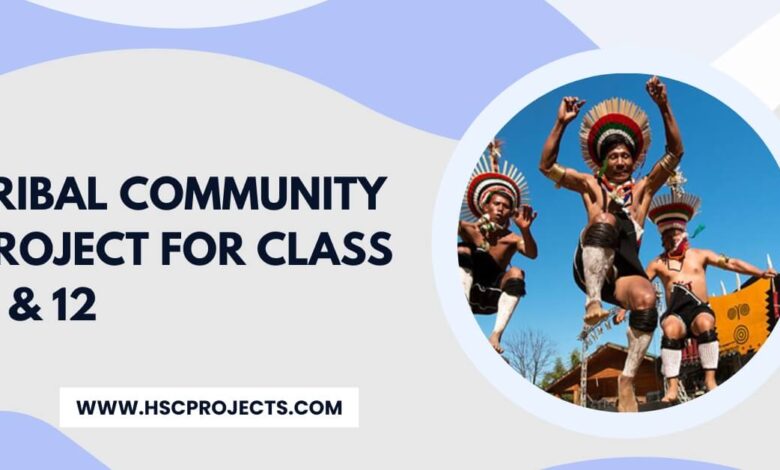
Tribal Community Project For Class 11 & 12
Acknowledgment:
First and foremost, I extend my heartfelt thanks to [Teacher’s Name], my mentor and guide, whose guidance, encouragement, and valuable feedback have been indispensable throughout the project. Your insights and expertise have shaped the project’s direction and improved its overall quality.
I am also deeply thankful to the members of the tribal communities who graciously shared their time and experiences with me during interviews and interactions. Their openness and willingness to share their stories have enriched this project and provided valuable insights into the challenges they face and the beauty of their culture.
I would like to acknowledge the support of my family and friends for their understanding, encouragement, and motivation during the entire process. Their unwavering belief in me kept me focused and motivated to pursue this project with dedication.
Last but not least, I extend my appreciation to the academic institutions and libraries that provided access to essential research materials, without which this project would not have been possible.
Thank you to everyone involved in this project directly or indirectly. Your support has made this project a fulfilling and enlightening learning experience.
[Your Name]Please make sure to replace the placeholders ([Teacher’s Name], [Your Name]) with the actual names. Also, feel free to customize the acknowledgment based on your specific interactions and contributions you received during the project.
Introduction to Tribal Communities:
Tribal communities, also known as indigenous or native communities, are groups of people who have distinct cultural, historical, and social identities rooted in their traditional territories. These communities have inhabited specific regions for generations, preserving unique customs, languages, belief systems, and practices that distinguish them from the larger dominant societies surrounding them.
One of the defining characteristics of tribal communities is their close relationship with the land they inhabit. Many tribes have a deep spiritual and cultural connection to their natural surroundings, which often play a vital role in their livelihoods, traditions, and rituals.
Tribal societies are diverse, and each community has its own way of life, governance structure, and social norms. These societies may range from nomadic hunter-gatherer groups to settled agricultural communities. Despite their differences, tribal communities share common challenges, such as land rights, cultural preservation, access to basic services, and socio-economic development.
Historically, tribal communities have faced marginalization, exploitation, and discrimination, especially in the context of colonization and modernization. Many have struggled to retain their cultural heritage while adapting to the changing world around them.
Tribal communities continue to contribute significantly to the world’s cultural diversity and possess valuable knowledge about sustainable living practices, natural medicine, and environmental conservation. Understanding and supporting tribal communities’ rights and aspirations are crucial steps towards achieving a more inclusive and equitable society.
Throughout this project, we will delve deeper into the cultural aspects, social structure, challenges, and potential solutions concerning tribal communities. By doing so, we hope to gain a broader perspective on these remarkable groups and foster a greater appreciation for their rich cultural heritage and contributions to humanity.
Cultural cspects of tribal communities:
- Traditions and Customs: Tribal communities have a treasure trove of age-old traditions and customs that have been passed down through generations. These customs often govern social interactions, ceremonies, festivals, marriages, and daily life activities. They play a vital role in maintaining social cohesion and preserving the unique identity of the community.
- Oral Tradition: Many tribal communities rely on oral tradition to pass on knowledge, history, myths, and folktales from one generation to the next. Elders are the custodians of wisdom, and storytelling is an integral part of preserving cultural heritage and imparting life lessons.
- Art and Craftsmanship: Tribal communities are renowned for their artistic skills and craftsmanship. They produce exquisite handicrafts, textiles, pottery, woodwork, and metalwork, often showcasing intricate designs and patterns unique to their culture. These art forms reflect their deep connection with nature, spirituality, and daily life.
- Music and Dance: Music and dance are integral components of tribal culture. Vibrant rhythms, traditional instruments, and rhythmic movements play significant roles in religious ceremonies, festivals, and social gatherings. These expressive art forms are not only a means of entertainment but also a way to celebrate life and their cultural heritage.
- Religious and Spiritual Beliefs: Tribal communities often have distinct religious and spiritual beliefs that are closely tied to nature and the environment. They worship natural elements, animals, and ancestral spirits, viewing their surroundings as sacred and interconnected.
- Rites of Passage: Various rites of passage mark significant milestones in the lives of tribal community members. These include birth rituals, initiation ceremonies, marriage celebrations, and death rituals. Rites of passage hold deep cultural and spiritual significance, signifying transitions from one life stage to another.
- Languages and Dialects: Tribal communities often have their own languages or dialects, which are vital components of their identity. Language not only helps them communicate but also carries cultural knowledge and understanding of their environment.
- Traditional Healing Practices: Tribal communities possess a wealth of knowledge about herbal medicine and traditional healing practices. Their understanding of the medicinal properties of plants and natural remedies has been handed down through generations and is an essential part of their healthcare system.
- Cultural Festivals and Gatherings: Tribal festivals and gatherings are joyous occasions that bring the community together. These events provide opportunities for cultural expression, bonding, and the passing on of traditions to younger members.
- Cultural Dress and Adornments: The traditional attire and adornments of tribal communities are reflective of their cultural identity and often feature unique designs, colors, and symbols. These garments hold cultural significance and are worn during special occasions and ceremonies.
- Understanding and appreciating the cultural aspects of tribal communities not only fosters cultural diversity and inclusivity but also aids in the preservation of their rich heritage. By respecting and valuing their traditions, we contribute to the recognition and empowerment of these unique societies.

Government policies and Initiatives:
- Tribal Welfare and Development Programs: Governments may implement targeted welfare and development programs to address the socio-economic disparities faced by tribal communities. These initiatives could include schemes for education, healthcare, housing, skill development, and employment opportunities.
- Land Rights and Forest Governance: Securing land rights for tribal communities is a crucial aspect of policy efforts. Governments may establish or strengthen mechanisms to recognize and protect the land and resource rights of indigenous peoples. This includes provisions for community land titles, traditional forest management, and recognition of sacred sites.
- Reservation and Affirmative Action: Many countries have reservation policies that allocate a certain percentage of government jobs, educational seats, and other benefits specifically for tribal communities. Affirmative action measures aim to promote representation and upliftment of marginalized groups, including tribes.
- Cultural Heritage Preservation: Governments may establish institutions or programs to preserve and promote tribal cultures, languages, traditional knowledge, and art forms. This can involve setting up museums, cultural centers, and funding projects that safeguard intangible cultural heritage.
- Scheduled Tribes (ST) Status: In some countries, tribal communities are officially recognized as Scheduled Tribes, which grants them specific constitutional protections and privileges. These protections can include safeguards against exploitation and discrimination.
- Tribal Sub-Plans: Some governments may create dedicated funds and plans called Tribal Sub-Plans (TSP) or Tribal Area Development Plans (TADP) to allocate resources for the overall development of tribal regions and communities.
- Participatory Governance: Efforts may be made to involve tribal communities in decision-making processes that affect their lives. This includes consulting with tribal representatives and involving them in the planning and implementation of development projects.
- Health and Education Initiatives: Special healthcare and educational programs may be designed to cater to the specific needs of tribal communities, including the establishment of schools, hostels, and healthcare centers in tribal areas.
- Livelihood and Skill Development: Initiatives may focus on enhancing the livelihood options for tribal communities by promoting sustainable agricultural practices, providing training in traditional crafts, and facilitating access to markets.
- Community Empowerment and Self-Governance: In some cases, governments may support efforts to strengthen traditional tribal institutions, such as village councils or community-based organizations, to promote self-governance and decision-making.
It is important to note that while these policies and initiatives are intended to uplift tribal communities, their implementation and effectiveness can vary. Some policies may face challenges due to bureaucratic hurdles, lack of awareness, or resistance from vested interests. Therefore, consistent evaluation, feedback from tribal communities, and periodic improvements are crucial to ensuring the desired outcomes of these initiatives.
Case studies:
Case Study 1: The Adivasis of India
Challenges:
Land Rights: Adivasis often struggle to assert their land rights, leading to land grabs and displacement due to development projects like mining and dams.
Education
Poverty and Unemployment: Adivasis experience higher poverty rates and unemployment, with limited opportunities for skill development and livelihood enhancement.
cultural eros
Government Initiatives:
Scheduled Tribes and Other Traditional Forest Dwellers (Recognition of Forest Rights) Act, 2006: This legislation recognizes the rights of Adivasis and other forest-dwelling communities over forestland they have inhabited for generations, empowering them to protect their natural resources and cultural heritage.
Tribal Sub-Plan (TSP): The Government of India allocates funds under the Tribal Sub-Plan to ensure targeted development schemes and projects for tribal communities.
Integrated Tribal Development Agencies (ITDAs): These agencies are set up in tribal regions to implement comprehensive development programs, including education, health, infrastructure, and livelihood projects.
Case Study 2: The Maasai of Kenya and Tanzania
The Maasai are pastoralist ethnic groups residing primarily in Kenya and Tanzania. They lead a nomadic or semi-nomadic lifestyle and have a distinct cultural identity centered around cattle herding.
Challenges:
Land Disputes: The Maasai face ongoing land conflicts due to expansion of national parks, agricultural encroachment, and tourism development, leading to loss of grazing lands.
Education and Livelihoods: Limited access to education and alternative livelihood opportunities can hinder their socio-economic progress.
Cultural Preservation: Modernization and external influences pose challenges to preserving Maasai traditions and customs.
Government and NGO Initiatives:
Community-Based Conservation: Collaborative conservation projects involving Maasai communities, governments, and NGOs aim to balance wildlife conservation with the needs of local populations, fostering coexistence.
Land Rights and Reserves: Efforts to secure land rights for Maasai communities have led to the establishment of conservancies and protected areas where Maasai can sustain their pastoralist way of life.
Education and Skill Development: NGOs and governmental organizations provide support for education and vocational training, empowering Maasai youth with knowledge and skills for better opportunities.
These case studies highlight the complexities and diverse approaches taken to address the challenges faced by tribal communities. While there have been positive developments, ongoing efforts are needed to ensure the preservation of their cultural heritage, secure land rights, and improve socio-economic conditions for a more sustainable and inclusive future.
Conclusion:
Throughout our exploration of tribal communities, we discovered the following key points:
Cultural Diversity and Identity: Tribal communities have distinct cultural identities, encompassing traditions, art forms, languages, and spiritual beliefs that have been preserved through generations. Their cultural diversity enriches the global tapestry of humanity.
Socio-Economic Challenges: Many tribal communities confront socio-economic disparities, including poverty, lack of access to education and healthcare, and limited livelihood opportunities. Land rights issues, displacement, and cultural erosion further compound their struggles.
Government Initiatives: Governments and NGOs have implemented various policies and programs to address the needs of tribal communities. These initiatives encompass land rights recognition, welfare programs, cultural preservation efforts, education, and skill development.
Cultural Preservation and Empowerment: Preserving tribal cultures and empowering communities to participate in decision-making processes are essential for their self-determination and well-being.
Environmental Stewardship: Tribal communities often exhibit a strong connection to the natural world and practice sustainable living. Their knowledge of ecological balance and traditional practices contributes to environmental conservation efforts.
Inclusive Development: Emphasizing inclusive development strategies that respect tribal rights and culture is vital to achieving equitable progress and ensuring that tribal communities are not left behind.
The case studies of the Adivasis in India and the Maasai in Kenya and Tanzania exemplify the diversity of challenges faced by tribal communities and the efforts made by governments and organizations to support their development and cultural preservation.
As we move forward, it is crucial to continue recognizing the rights and contributions of tribal communities, engaging in meaningful dialogues, and implementing sustainable development initiatives that empower these communities to thrive while preserving their unique cultural heritage.
Certificate of completion
[Your School/Institution Logo]Date: [Current Date]
Dear [Teacher’s Name],
I am thrilled to present my completed project on “Tribal Community: Challenges and Sustainable Development” for Class 11 and 12. This project has been an eye-opening and transformative journey, allowing me to explore the unique culture, issues, and opportunities within tribal communities.
Throughout this project, I immersed myself in understanding the rich cultural heritage and traditions of various tribal communities. I learned about their social structures, art, language, and customs, which have been preserved for generations and are an integral part of their identity.
I also delved into the challenges faced by tribal communities in modern times. These challenges range from economic hardships, lack of access to quality education and healthcare, to issues related to land rights and environmental conservation. Recognizing these challenges has highlighted the urgent need for sustainable development solutions that respect their culture and empower them to thrive.
Furthermore, I researched the importance of preserving indigenous knowledge and practices, as they often hold valuable insights into sustainable living and environmental conservation. Learning about their holistic approach to health, agriculture, and natural resource management has been truly inspiring.
To better comprehend the issues faced by tribal communities, I had the privilege of engaging with members of a local tribal community. The insightful conversations and interactions with community members provided me with real-life perspectives and a deeper appreciation for their resilience and wisdom.
Additionally, I explored various initiatives and projects implemented by governments, NGOs, and other organizations aimed at uplifting tribal communities. I analyzed the successes and challenges of these projects to understand how best to approach sustainable development that respects their cultural heritage and aspirations.
I am deeply grateful for the resources available to me during this research, including academic literature, documentaries, and interviews. These resources played a crucial role in gathering reliable information and presenting a well-supported analysis of tribal communities’ issues and sustainable development.
Completing this project has been an enriching experience, and it has ignited my passion for contributing positively to the lives of tribal communities. I am committed to raising awareness about their challenges and advocating for sustainable development that preserves their cultural heritage and empowers their future.
Receiving this Certificate of Appreciation is an honor, and I am sincerely grateful for the opportunity to work on the “Tribal Community: Challenges and Sustainable Development” project. I hope that the insights and knowledge gained from this project can contribute to fostering empathy, understanding, and support for tribal communities.
Once again, I extend my heartfelt thanks to everyone who supported and contributed to the successful completion of the “Tribal Community: Challenges and Sustainable Development” project. Your encouragement and assistance have been invaluable, and I am deeply appreciative of your belief in my abilities.
Sincerely,
[Your Name]In order to download the PDF, You must follow on Youtube. Once done, Click on Submit
Follow On YoutubeSubscribed? Click on Confirm
Download Tribal Community Project For Class 11 & 12 PDF






